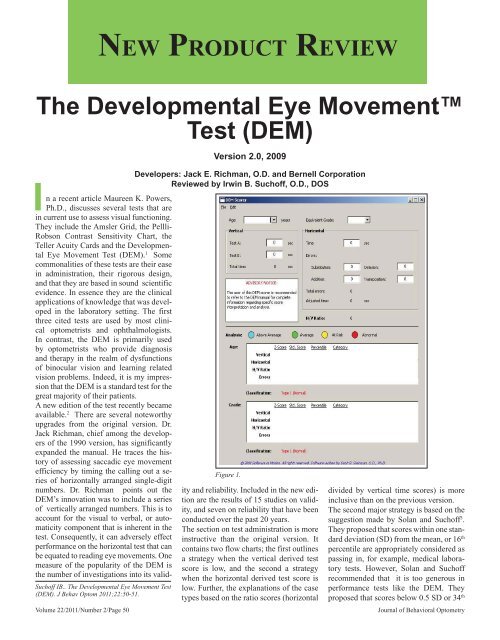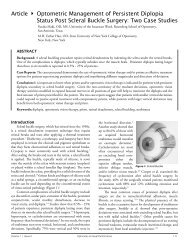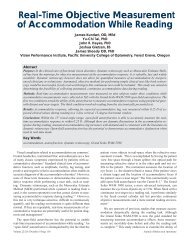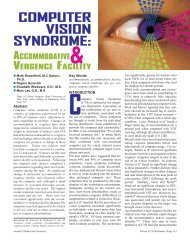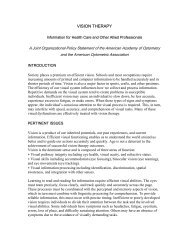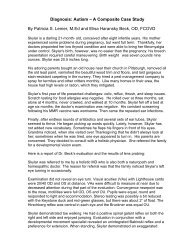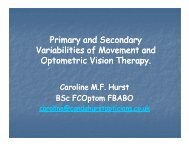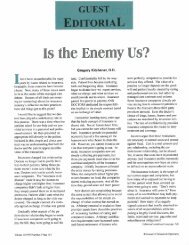The Developmental Eye Movement™ Test (DEM) - Optometric ...
The Developmental Eye Movement™ Test (DEM) - Optometric ...
The Developmental Eye Movement™ Test (DEM) - Optometric ...
You also want an ePaper? Increase the reach of your titles
YUMPU automatically turns print PDFs into web optimized ePapers that Google loves.
Volume 22/2011/Number 2/Page 50<br />
NEW PRODUCT REVIEW<br />
<strong>The</strong> <strong>Developmental</strong> <strong>Eye</strong> Movement<br />
<strong>Test</strong> (<strong>DEM</strong>)<br />
In a recent article Maureen K. Powers,<br />
Ph.D., discusses several tests that are<br />
in current use to assess visual functioning.<br />
<strong>The</strong>y include the Amsler Grid, the Pellli-<br />
Robson Contrast Sensitivity Chart, the<br />
Teller Acuity Cards and the <strong>Developmental</strong><br />
<strong>Eye</strong> Movement <strong>Test</strong> (<strong>DEM</strong>). 1 Some<br />
commonalities of these tests are their ease<br />
in administration, their rigorous design,<br />
and that they are based in sound scientific<br />
evidence. In essence they are the clinical<br />
applications of knowledge that was developed<br />
in the laboratory setting. <strong>The</strong> first<br />
three cited tests are used by most clinical<br />
optometrists and ophthalmologists.<br />
In contrast, the <strong>DEM</strong> is primarily used<br />
by optometrists who provide diagnosis<br />
and therapy in the realm of dysfunctions<br />
of binocular vision and learning related<br />
vision problems. Indeed, it is my impression<br />
that the <strong>DEM</strong> is a standard test for the<br />
great majority of their patients.<br />
A new edition of the test recently became<br />
available. 2 <strong>The</strong>re are several noteworthy<br />
upgrades from the original version. Dr.<br />
Jack Richman, chief among the developers<br />
of the 1990 version, has significantly<br />
expanded the manual. He traces the history<br />
of assessing saccadic eye movement<br />
efficiency by timing the calling out a series<br />
of horizontally arranged single-digit<br />
numbers. Dr. Richman points out the<br />
<strong>DEM</strong>’s innovation was to include a series<br />
of vertically arranged numbers. This is to<br />
account for the visual to verbal, or automaticity<br />
component that is inherent in the<br />
test. Consequently, it can adversely effect<br />
performance on the horizontal test that can<br />
be equated to reading eye movements. One<br />
measure of the popularity of the <strong>DEM</strong> is<br />
the number of investigations into its valid-<br />
Suchoff IB.. <strong>The</strong> <strong>Developmental</strong> <strong>Eye</strong> Movement <strong>Test</strong><br />
(<strong>DEM</strong>). J Behav Optom 2011;22:50-51.<br />
Version 2.0, 2009<br />
Developers: Jack E. Richman, O.D. and Bernell Corporation<br />
Reviewed by Irwin B. Suchoff, O.D., DOS<br />
Figure 1.<br />
ity and reliability. Included in the new edition<br />
are the results of 15 studies on validity,<br />
and seven on reliability that have been<br />
conducted over the past 20 years.<br />
<strong>The</strong> section on test administration is more<br />
instructive than the original version. It<br />
contains two flow charts; the first outlines<br />
a strategy when the vertical derived test<br />
score is low, and the second a strategy<br />
when the horizontal derived test score is<br />
low. Further, the explanations of the case<br />
types based on the ratio scores (horizontal<br />
divided by vertical time scores) is more<br />
inclusive than on the previous version.<br />
<strong>The</strong> second major strategy is based on the<br />
suggestion made by Solan and Suchoff 3 .<br />
<strong>The</strong>y proposed that scores within one standard<br />
deviation (SD) from the mean, or 16 th<br />
percentile are appropriately considered as<br />
passing in, for example, medical laboratory<br />
tests. However, Solan and Suchoff<br />
recommended that it is too generous in<br />
performance tests like the <strong>DEM</strong>. <strong>The</strong>y<br />
proposed that scores below 0.5 SD or 34 th<br />
Journal of Behavioral Optometry
<strong>DEM</strong> Reading <strong>Eye</strong> Movement <strong>Test</strong><br />
Scoring software © 2008 Software In Motion. All rights reserved.<br />
Software written by Scott Steinman, O.D., Ph.D.<br />
Patient Name:___________________________________________________<br />
Exam Date:________________<br />
Age: 9 Equivalent Grade: 4<br />
Vertical<br />
<strong>Test</strong> A: 23 sec<br />
<strong>Test</strong> B: 22 sec<br />
Total time: 45 sec<br />
Horizontal<br />
Time: 58 sec<br />
Errors:<br />
Substitution: 0 Omission: 2<br />
Addition: 0 Transposition: 0<br />
Total errors: 2<br />
Adjusted time: 59.48718 sec<br />
H/V Ratio: 1.32<br />
Analysis by Age:<br />
Z Score Std Score %ile<br />
Vertical: -0.33 95 37% Normal Performance (Average)<br />
Horizontal: -0.63 91 26% Normal Performance (Average)<br />
H/V Ratio: -0.59 91 28% Normal Performance (Average)<br />
Errors: 0.04 101 52% Normal Performance (Average)<br />
Classification: Type 1 (Normal)<br />
Analysis by Equivalent Grade:<br />
Z Score Std Score %ile<br />
Vertical: -0.52 92 30% Normal Performance (Average)<br />
Horizontal: -1.34 80 9% Borderline Performance (At Risk)<br />
H/V Ratio: -0.8 88 21% Normal Performance (Average)<br />
Errors: -0.01 100 50% Normal Performance (Average)<br />
Classification: Unknown type<br />
Figure 2.<br />
percentile are more appropriate for these<br />
types of tests. This concept was refined<br />
and expanded by Tassinari. 4 He suggested<br />
that while one SD cutoff is appropriate for<br />
visually non-symptomatic children, it is<br />
not for symptomatic children. For the latter<br />
group, a cut off of 0.5 SD is more useful.<br />
A list of generally accepted symptoms<br />
is included in the manual.<br />
This type of differentiation is made clinically<br />
easy to determine by virtue of the<br />
last of the upgrades. A compact disc is<br />
included with the new edition. <strong>The</strong> examiner<br />
chooses from the menu whether the<br />
performance is to be scored as part of a<br />
screening program for non-symptomatic<br />
patients, or as a clinical program for those<br />
who are symptomatic. <strong>The</strong> testing goes<br />
on as originally proscribed, but the examiner<br />
then inserts the raw time and error<br />
scores into the appropriate spaces in the<br />
basic computer screen image rather than<br />
on a sheet of paper. See Figure 1. When<br />
all required information is placed in the<br />
spaces of the basic screen, the computer<br />
analyzes the results according to age and<br />
equivalent grade. This negates the ne-<br />
Journal of Behavioral Optometry<br />
<strong>DEM</strong> Reading <strong>Eye</strong> Movement <strong>Test</strong><br />
Scoring software © 2008 Software In Motion. All rights reserved.<br />
Software written by Scott Steinman, O.D., Ph.D.<br />
Patient Name:___________________________________________________<br />
Exam Date:________________<br />
Age: 9 Equivalent Grade: 4<br />
Vertical<br />
<strong>Test</strong> A: 23 sec<br />
<strong>Test</strong> B: 22 sec<br />
Total time: 45 sec<br />
Horizontal<br />
Time: 58 sec<br />
Errors:<br />
Substitution: 0 Omission: 2<br />
Addition: 0 Transposition: 0<br />
Total errors: 2<br />
Adjusted time: 59.48718 sec<br />
H/V Ratio: 1.32<br />
Analysis by Age:<br />
Z Score Std Score %ile<br />
Vertical: -0.33 95 37% Normal Performance (Average)<br />
Horizontal: -0.63 91 26% Borderline Performance (At Risk)<br />
H/V Ratio: -0.59 91 28% Borderline Performance (At Risk)<br />
Errors: 0.04 101 52% Normal Performance (Average)<br />
Classification: At risk for Type 2 (Oculomotor)<br />
Analysis by Equivalent Grade:<br />
Z Score Std Score %ile<br />
Vertical: -0.52 92 30% Borderline Performance (At Risk)<br />
Horizontal: -1.34 80 9% Abnormal (Impaired)<br />
H/V Ratio: -0.8 88 21% Borderline Performance (At Risk)<br />
Errors: -0.01 100 50% Normal Performance (Average)<br />
Classification: At risk for Type 4 (Mixed)<br />
Figure 3.<br />
cessity of manually going to the age and<br />
grade equivalent tables that are required<br />
in the original edition of the <strong>DEM</strong>. Figure<br />
2 depicts the performance and assessment<br />
of a patient who is non symptomatic and<br />
is scored at the one SD level. Figure 3<br />
shows the same performance, but different<br />
age and grade equivalent assessments<br />
when the patient is symptomatic<br />
and scored at the 0.5 SD level. <strong>The</strong> color-coded<br />
circles in Figure 1 indicate the<br />
performance level for each component of<br />
the analyses in Figures 2 and 3. Dr. Barry<br />
Tannen of Hamilton Square, NJ, and Dr.<br />
Sharon Berger of Roswell, GA, are both<br />
recent users of the new edition of the<br />
<strong>DEM</strong>. <strong>The</strong>y both noted the ease of use as<br />
compared to the first version. Dr. Tannen<br />
commented that a feature was the automatic<br />
categorization of the patient into the<br />
typing that finds the patient to be within<br />
the expected in terms of the automaticity<br />
and ocular motor interactions, or if one<br />
or both of these factors are below the expecteds.<br />
Dr. Berger had stopped using the<br />
<strong>DEM</strong> but has routinely began using it, and<br />
particularly liked the computer print out<br />
that she stores in the patient record.<br />
Dr. Suchoff has no financial interest in<br />
Bernell Corporation.<br />
References:<br />
1. Powers MK. Paper tools for assessing visual<br />
function. Optom Vis Sci 2009;86:613-18.<br />
2. <strong>The</strong> <strong>Developmental</strong> <strong>Eye</strong> MovementTM <strong>Test</strong> Version<br />
2.0, 2009. Bernell Corporation. 4016 N<br />
Home St. Mishawaka, IN 45695.<br />
3. Solan HA, Suchoff IB. <strong>Test</strong>s and Measurements<br />
for Behavioral Optometrists. Santa Ana, CA:<br />
<strong>Optometric</strong> Extension Program, Curriculum<br />
II,1991:18-20.<br />
4. Tassanari JT. Assessing the assessment: Learning<br />
related vision problems test scores revisited. J<br />
Optom Vision Dev 2008;39:128.<br />
For product information:<br />
Bernell Corporation<br />
4016 N. Home St.<br />
Mishawaka, IN 46545<br />
www.bernell.com<br />
Volume 22//2011/Number 2/Page 51


